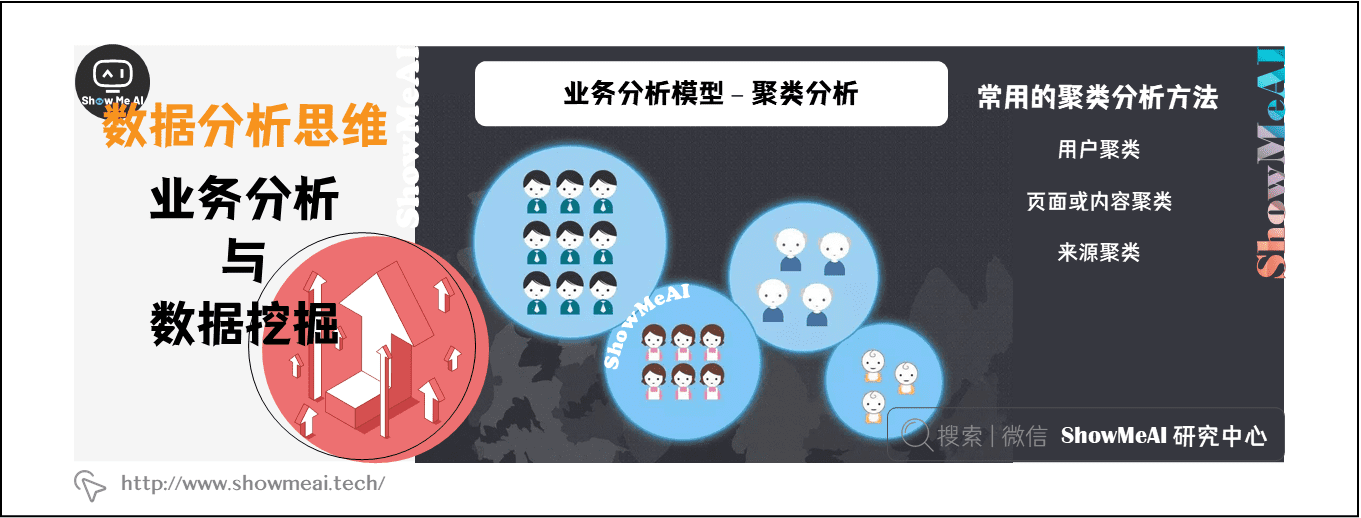数据挖掘中的聚类分析:算法详解与商业应用,让你快速上手!
发布时间: 2024-09-01 17:45:44 阅读量: 102 订阅数: 77 


# 1. 聚类分析概述
聚类分析是数据挖掘中的一种无监督学习技术,它将大量数据根据某种相似性度量分成多个类别或“簇”,使得同一簇内的数据点比不同簇的数据点更为相似。它是数据科学、机器学习、模式识别等领域的基础工具,广泛应用于生物学、市场研究、图像分析等多个领域。
聚类可以帮助我们理解数据的内在结构和分布,揭示样本间的关联性,为后续的数据分析工作奠定基础。聚类技术的种类繁多,包括基于距离的聚类、基于密度的聚类、基于模型的聚类等。接下来的章节,我们将深入了解这些聚类算法,并探讨它们在不同行业中的实际应用。
# 2. 聚类算法详解
## 2.1 基于距离的聚类算法
距离是聚类算法中非常核心的概念,它用于衡量不同数据点之间的相似度或相异度。在基于距离的聚类算法中,将距离相近的数据点划分为同一类,是数据聚类的基础。
### 2.1.1 K-Means算法原理及实现
K-Means算法是一种广泛使用的基于距离的聚类方法,它通过迭代寻找数据的最优聚类中心,以此将数据集分为K个簇。K-Means算法的基本步骤如下:
1. 随机选择K个数据点作为初始的聚类中心。
2. 将每个数据点分配给最近的聚类中心,形成K个簇。
3. 重新计算每个簇的中心点,即簇内所有点的均值。
4. 重复步骤2和步骤3,直到聚类中心不再发生变化或达到预设的迭代次数。
以下是K-Means算法的Python实现示例:
```python
import numpy as np
from sklearn.cluster import KMeans
# 示例数据集
X = np.array([[1, 2], [1, 4], [1, 0],
[10, 2], [10, 4], [10, 0]])
# 设置簇的数量
kmeans = KMeans(n_clusters=2, random_state=0).fit(X)
# 输出聚类中心
print("Cluster centers:")
print(kmeans.cluster_centers_)
# 输出每个点的簇标签
print("Labels for each point:")
print(kmeans.labels_)
```
在上述代码中,我们首先导入了必要的库,然后定义了一个简单的二维数据集`X`。接下来,我们使用`sklearn.cluster.KMeans`类创建了K-Means对象,并设置`n_clusters=2`来指定要划分的簇的数量。通过调用`fit`方法对数据进行聚类,并通过`cluster_centers_`属性获取了聚类中心,`labels_`属性获得了每个数据点的簇标签。
### 2.1.2 层次聚类分析过程和应用
层次聚类算法是另一种基于距离的聚类方法,它通过构建一个聚类的层次结构来对数据进行聚类。这种算法可以进一步分为自下而上(凝聚)和自上而下(分裂)的两种方法。
层次聚类的基本步骤如下:
1. 将每个数据点视为一个独立的簇。
2. 按照某种准则(如距离最小)合并最近的两个簇。
3. 重复步骤2,直到达到预设的簇数量或满足其他停止条件。
层次聚类算法的Python实现可以使用`sklearn.cluster.AgglomerativeClustering`类,下面是一个简单的示例:
```python
from sklearn.cluster import AgglomerativeClustering
from sklearn.datasets import make_blobs
# 创建合成数据集
X, _ = make_blobs(n_samples=300, centers=4, cluster_std=0.60, random_state=0)
# 应用凝聚层次聚类
cluster = AgglomerativeClustering(n_clusters=4)
labels = cluster.fit_predict(X)
print("Labels for each point:")
print(labels)
```
在这个示例中,我们首先使用`make_blobs`函数生成了一个含有4个簇的数据集`X`,然后通过`AgglomerativeClustering`类创建了层次聚类模型,并通过`fit_predict`方法同时拟合并预测每个数据点的簇标签。最终,`labels`数组中的每个元素代表对应数据点的簇标签。
通过层次聚类,我们可以直观地通过一个树状结构(也称为Dendrogram)来分析数据的层次结构关系,这对于一些应用场合尤其有用,如生物信息学中的物种分类,或者市场研究中的顾客细分。
# 3. 聚类算法的商业应用案例分析
聚类算法在商业领域中有着广泛的应用,从客户细分、市场分析到社交媒体数据挖掘,聚类技术帮助企业和组织从海量数据中挖掘出潜在的价值。本章节将深入探讨聚类算法在不同商业场景中的具体应用案例。
## 3.1 客户细分与市场分析
### 3.1.1 应用K-Means进行客户细分
在市场分析中,K-Means是一种常见的聚类方法,它将具有相似特征的客户归为一类,帮助营销人员更有效地制定针对性的市场策略。利用K-Means算法,企业可以根据客户的购买行为、人口统计数据等信息将客户分为不同的群体。
一个典型的客户细分流程包括以下步骤:
1. **数据准备**:收集客户的交易数据和相关属性,如年龄、性别、购买频次、购买金额等。
2. **数据预处理**:进行数据清洗和标准化,以减少数据噪声和特征间的尺度差异。
3. **确定簇数**:选择合适的K值(簇的数量),通常使用轮廓系数、肘部法则等方法确定。
4. **执行K-Means算法**:利用K-Means算法对数据集进行聚类,并迭代更新簇的中心点直至收敛。
5. **结果分析**:根据聚类结果,对每个簇内的客户特征进行分析,识别出不同细分市场的特征。
下面是一个简化版的K-Means算法的Python代码示例:
```python
from sklearn.cluster import KMeans
import numpy as np
# 假设X是包含客户特征的二维数据集
X = np.array([[1, 2], [1, 4], [1, 0],
[10, 2], [10, 4], [10, 0]])
# 设置簇数K为2
kmeans = KMeans(n_clusters=2, random_state=0).fit(X)
# 获取簇中心点和每个点所属的簇标签
centers = kmeans.cluster_centers_
labels = kmeans.labels_
print("Cluster centers:\n", centers)
print("Labels:", labels)
```
在这个例子中,`KMeans`类来自`sklearn.cluster`模块,`fit`方法用于计算簇中心点,并对数据集`X`进行聚类。输出结果会展示每个簇的中心点坐标和数据点所属的簇标签。
### 3.1.2 基于聚类的市场细分策略
市场细分策略是企业战略
0
0





